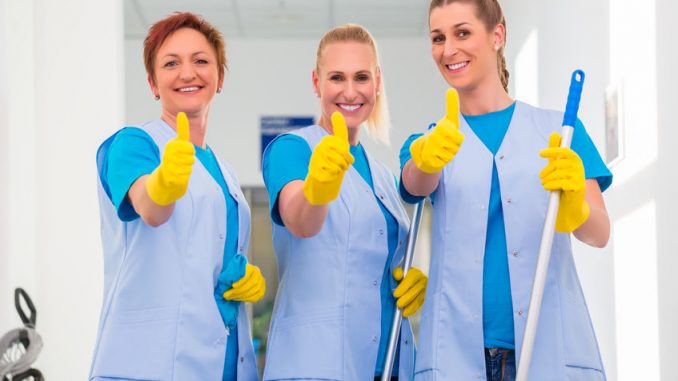
Cleaning a food premise, be it a catering or manufacturing firm is an essential requirement of good hygiene and housekeeping. Failure to do so can lead to closure of the premises by environmental health officers upon inspection.
The formal definition of cleaning ‘is the systematic application of energy with the intention of removing unwanted material from any surface such as soil and dirt, and food materials.’
Employers and occupiers of food premises are required to keep their sites, their equipment and any other items involved in food production clean as instructed under the Workplace (Health, Safety and Welfare) Regulations 1992 and Food Hygiene (England) Regulations 2006. If a premise is unclean and there is poor housecleaning, it is often the prime indicator of poor management and control of the site. It is one of the main contributors to food poisoning, accidents and sub-standard manufacturing.
The Hazards From Ineffective Cleaning
The classic issues due to ineffectual cleaning are the following:
- cross-contamination
- chemical contamination
- physical contamination
- allergenic contamination
- a failure to remove and destroy micro-organisms.
The main reason for cleaning and disinfection is to reduce the risk of food poisoning. It achieves this by the following means:-
- removes the micro-organism’s food supply
- cleaning allows for further disinfecting
- removes material which encourages pests
- removes ‘foreign matter’ contamination
- removes dirt and grease
- promotes a better, more favourable image of the facilities
- complies with the law
- reduced customer complaints
- provides a safe and environmentally acceptable working environment.
The Energy Used In Cleaning
As the definition of cleaning states, we need energy to achieve removal of dirt. The kinetic energies used are physical ones such as scrubbing and brushing, use of mechanical methods based on cleaning machines and turbulent forms using running water. The thermal approach relies on very hot water to impart energy.
The chemicals used are mainly detergents which remove grease and other forms of soiling. These are available as liquids, powders, gels and foams. A detergent is a chemical used to remove dirt, grease and food particles but does not kill bacteria.
Classification of Detergents
The Alkaline types have poor wetting properties. These are also corrosive to the skin but effective against fat and protein and is relatively inexpensive. The Acid types of detergent are mainly used to remove minerals, proteins and vegetable deposits. These are corrosive too and if they come into contact with chlorine compounds some acid detergents such as phosphoric acids will release their toxic gases.
The most common types used for cleaning are neutral agents which are often blends of surfactants which are relatively safe to use.
How Does The Detergent Work ?
A detergent is characterised by the following properties:-
- Surfactancy: it can reduce the surface tension between the soil so allowing the detergent to penetrate the dirt.
- Dispersion: it lifts dirt off the surface by reducing the surface tension of water, thus increasing contact between soil and detergent, allowing dirt to be penetrated more effectively.
- It keeps the dirt in suspension and is not redeposited.
- Sequestrant: An agent is incorporated into detergents such as a water-softening agent to prevent lime scale and hard soap deposits forming.
Disinfection
A disinfectant is a chemical used to reduce micro-organisms to a safe level.
Types of Disinfectant
- iodophors
- alcohols
- chlorine release
- peroxy compounds
- amphoteric compounds
- quarternary ammonium compounds
- ozone
- biguanides
The selection of a chemical disinfectant depends on the following factors:-
- odour
- toxicity
- type of micro-organism present
- type of surface to be cleaned
- does it taint ?
- the temperature required for application
- the level, age and type of soiling present
- the application method
- time available and allocated for disinfection
- compatability with water types – some perform better in soft water areas
- compatability with other chemicals used.
The Process Of Disinfection
The definition of disinfection is the reduction of micro-organisms to a safe level and is best achieved by the following:
- using hot water and steam. The hot water should be at least 82 °C and applied for 30 seconds
- a dishwasher is effective for cleaning plates, crockery and cutlery
- cloths need to be laundered at 82 °C to be effectively free of micro-organisms
- chemicals can be applied such as bleach (hypochlorite), alcohols and quaternary ammonium compounds (QACs)
Sterilization is not necessary or achievable in a food business by the way.
What Requires Cleaning and Disinfection?
The main surfaces that need cleaning are hand-contact and food-contact surfaces plus the cleaning materials and the equipment used for this purpose.
The issues that prevent effective disinfection are the presence of food scraps, soil and detergent. Sometimes the disinfectant has an inadequate contact time. The contact time incidentally is the time it takes for a chemical that needs to be left on a surface to ensure it is effective. The disinfectant can also be used at the wrong dilution or concentration.
Methods To Validate Effective Disinfection
The effectiveness of disinfection is determined by bacteriological monitoring using swabbing and with ATP measurement. Visual inspection is not an option.
The Stages Of Cleaning
There are six stages in cleaning:-
- Pre-cleaning
- Main cleaning
- Rinsing
- Disinfection
- Final rinse
- Air-drying
If the equipment surfaces are not considered to be dirty, then a three- or four-stage cleaning and sanitizing procedure can be implemented. This will involve the stages:-
- Pre-clean
- Sanitizing
- Rinse (if required)
- Air-drying.
If you are doing cleaning-in-place, a typical sequence consists of five steps:-
- Pre-rinse
- Detergent circulation
- intermediate rinse
- disinfectant circulation
- final rinse
Guidance
The Food Standards Agency has provided Guidance relating to the cleaning and disinfection controls for E.coli O157. The standards are contained in BS EN 1276:1997 or the BS EN 13697:2001 (or the equivalent). The guidance states:-
- sanitisers are combined detergents with disinfectant and are only used for general cleaning. These cannot be used if a surface will have dual use, or as a single stage for food contact surfaces.
- The staff must be fully trained to they understand the instructions and their use, including dilutions and contact times for these materials.
- The cleaning procedures must be in place.
- Steam must be suitable controlled
- Commercial dishwasher are preferred.
- We should not use the same equipment in raw foods areas and then in ready-to-eat areas or vice versa.
- Separate cloths must be designated for use only in clean environments
- In situations where cloths and other cleaning equipment are to be re-used in clean areas, the laundering should be carried out at a suitable high temperature. A wash that achieves 82 °C or higher is considered acceptable for this role.
- the procedures, including contractual arrangements, must ensure that cycles employed for the washing of cleaning cloths are not changed to lower temperatures as a result of energy efficiency reviews.
The Cleaning Schedule
Cleaning schedules and their operation are the means by which high standards of cleaning and housekeeping are implemented. Management corroboration of the implementation and external inspections ensure that the cleaning schedule is efficient, effective and meets the standards required. The schedule identifies each area to be cleaned, the items of machinery and plant, the materials and methods of cleaning and associated precautions and safety needed, the frequency for cleaning and those responsible for the task(s). The schedule is usually prepared in the form of a check-list with a simple tick system. There is also a section in the schedule to check cleaning has been performed satisfactorily by a responsible manager or supervisor and a comments section. The comments section is especially important if further action is required when there are issues in performance.
The cleaning schedule should define the following:-
The nature of the surface such as what it is, how it is cleaned, when to do it and the amount of time allowed for the job.
The cleaning schedule must be clearly written and verified.
The people who do the cleaning must be defined, must wear protective clothing, follow the safety procedures and perform both checks and record the activities concerned.
The chemicals must also be defined i.e. their type, how they are diluted, the amount of contact time, how they are stored. Some-one needs to check only approved chemicals are used.
The schedule should also define the type of equipment used. It’s important that when wet cleaning equipment is used, all the cloths are cleaned, disinfected and dried after use.
Use Of Contract Cleaners
The benefits of using contract cleaners are that they act as supplementary staff to in-house cleaners especially where specialist equipment needs to be used. They are sometimes used to clean difficult to reach parts of a factory. They also help maintain standards of hygiene that are not otherwise easily obtainable elsewhere. They can also be cost effective for periodic cleaning.
The issues and problems are that you need to carefully select and train many of the contract cleaners in the use of various chemicals for specific purposes. There also has to be a certain level of control and monitoring required and they also disrupt other’s work routines. There is a safety issue if they are using potentially dangerous chemicals and they too can cause contamination of food.
What The Manager Does In Organising A Cleaning Procedure
To conclude any manager who is organising an effective cleaning programme should follow these principles:-
they need to determine what cleaning tasks need to be completed in the time required, the level of safety and also how to avoid contaminating various surfaces used in the production of food.
They must consider the types of chemicals to be employed and the cleaning methods to use. This means having knowledge of the type of soil, the likely bacteria, chemical toxicity, level of dilution, how the chemicals are applied and the contact times needed for effective action. they must also decide on how often the cleaning is to be done, the period and frequency of this important procedure.
It is key that the manager investigates the suitability of each chemical for the task and that the appropriate equipment is available for this. The staff must be trained in procedures and cleaning methods, including the cleaning schedule. This schedule should be prepared by the manager in conjunction with the assigned staff. The staff must have this role defined in their job specification. It is generally accepted that job cards are used to show when the cleaning and monitoring has been conducted. It is also necessary to define the most appropriate monitoring method and have processes in place as to when these are conducted and by whom.
The whole cleaning schedule should be reviewed periodically to check feasibility and success based on the results of monitoring.
Summary
Cleaning is a critical process within any food, consumer healthcare and pharmaceutical process. Here we describe the general features of a cleaning process, the methods available and how they are to be monitored and controlled.

Leave a Reply